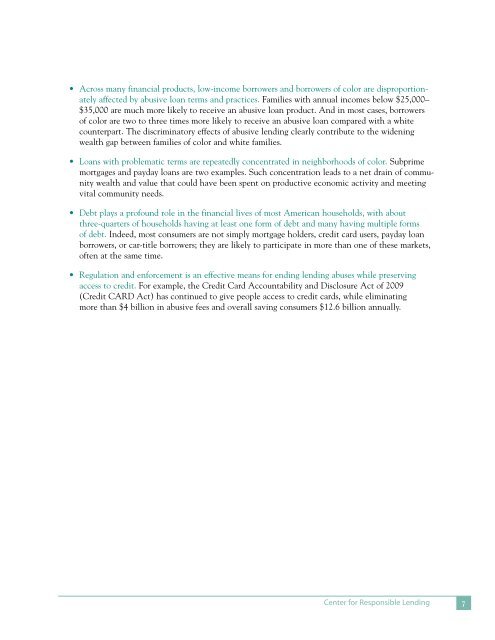Create successful ePaper yourself
Turn your PDF publications into a flip-book with our unique Google optimized e-Paper software.
• Across many financial products, low-income borrowers and borrowers <strong>of</strong> color are disproportionately<br />
affected by abusive loan terms and practices. Families with annual incomes below $25,000–<br />
$35,000 are much more likely to receive an abusive loan product. And in most cases, borrowers<br />
<strong>of</strong> color are two to three times more likely to receive an abusive loan compared with a white<br />
counterpart. <strong>The</strong> discriminatory effects <strong>of</strong> abusive lending clearly contribute to the widening<br />
wealth gap between families <strong>of</strong> color and white families.<br />
• Loans with problematic terms are repeatedly concentrated in neighborhoods <strong>of</strong> color. Subprime<br />
mortgages and payday loans are two examples. Such concentration leads to a net drain <strong>of</strong> community<br />
wealth and value that could have been spent on productive economic activity and meeting<br />
vital community needs.<br />
• Debt plays a pr<strong>of</strong>ound role in the financial lives <strong>of</strong> most American households, with about<br />
three-quarters <strong>of</strong> households having at least one form <strong>of</strong> debt and many having multiple forms<br />
<strong>of</strong> debt. Indeed, most consumers are not simply mortgage holders, credit card users, payday loan<br />
borrowers, or car-title borrowers; they are likely to participate in more than one <strong>of</strong> these markets,<br />
<strong>of</strong>ten at the same time.<br />
• Regulation and enforcement is an effective means for ending lending abuses while preserving<br />
access to credit. For example, the Credit Card Accountability and Disclosure Act <strong>of</strong> 2009<br />
(Credit CARD Act) has continued to give people access to credit cards, while eliminating<br />
more than $4 billion in abusive fees and overall saving consumers $12.6 billion annually.<br />
Center for Responsible Lending 7


